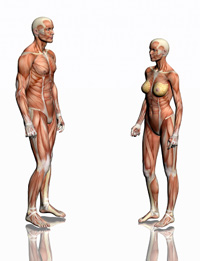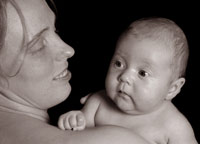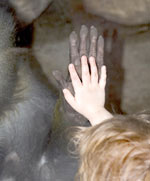|

 Bodies: Human body types vary substantially. Although body size is largely determined by genes, it is also significantly influenced by environmental factors such as diet and exercise. The average height of a North American adult female is 162 centimeters (5 feet 4 inches), and the average weight is 62 kilograms (137 pounds). Human males are typically larger than females: the average height and weight of a North American adult male is 175 centimeters (5 feet 9 inches) and 78 kilograms (172 pounds). Bodies: Human body types vary substantially. Although body size is largely determined by genes, it is also significantly influenced by environmental factors such as diet and exercise. The average height of a North American adult female is 162 centimeters (5 feet 4 inches), and the average weight is 62 kilograms (137 pounds). Human males are typically larger than females: the average height and weight of a North American adult male is 175 centimeters (5 feet 9 inches) and 78 kilograms (172 pounds).
The most bipedal animal: Humans are capable of fully bipedal locomotion, thus leaving their arms available for manipulating objects using their hands, aided especially by opposable thumbs. Because human physiology has not fully adapted to bipedalism, the pelvic region and vertebral column tend to become worn, creating locomotion difficulties in old age.
 Not the naked ape? Although humans appear relatively hairless compared to other primates, with notable hair growth occurring chiefly on the top of the head, underarms and pubic area, the average human has more hair on his or her body than the average chimpanzee. The main distinction is that human hairs are shorter, finer, and less colored than the average chimpanzee's, thus making them harder to see. Not the naked ape? Although humans appear relatively hairless compared to other primates, with notable hair growth occurring chiefly on the top of the head, underarms and pubic area, the average human has more hair on his or her body than the average chimpanzee. The main distinction is that human hairs are shorter, finer, and less colored than the average chimpanzee's, thus making them harder to see.
Many shades of hair and skin: The color of human hair and skin is determined by the presence of pigments called melanins. Human skin color can range from very dark brown to very pale pink, while human hair ranges from blond to brown to red, but most commonly, black. Most researchers believe that skin darkening was an adaptation that evolved as a defense against ultraviolet solar radiation: melanin is an effective sun-block. The skin color of contemporary humans is geographically stratified, and in general correlates with the level of ultraviolet radiation. Human skin also has a capacity to darken (sun tanning) in response to exposure to ultraviolet radiation.
Humans are a eukaryotic species. Each diploid cell has two sets of 23 chromosomes, each set received from one parent. There are 22 pairs of autosomes and one pair of sex chromosomes. By present estimates, humans have approximately 20,000–25,000 genes and share 98.4% of their DNA with their closest living evolutionary relatives, the two species of chimpanzees.
XX/XY: Like other mammals, humans have an XY sex-determination system, so that females have the sex chromosomes XX and males have XY. The X chromosome is larger and carries many genes not on the Y chromosome, which means that recessive diseases associated with X-linked genes, such as hemophilia, affect men more often than women.

The Human Brain: is the center of the central nervous system in humans, as well as the primary control center for the peripheral nervous system. The brain controls "lower", or involuntary, autonomic activities such as heart rate, respiration, and digestion. The brain also controls "higher" order, conscious activities, such as thought, reasoning, and abstraction. The human brain is generally regarded as more capable of these higher order activities, and more "intelligent" in general, than any other species. While other animals are capable of creating structures and using simple tools—mostly as a result of instinct and learning through mimicry—human technology is vastly more complex, constantly evolving and improving with time. Even the most ancient human tools and structures are far more advanced than any structure or tool created by any other animal.
Are humans the only animals to think abstractly? The human ability to think abstractly  may be unparalleled in the animal kingdom. Human beings are one of only six species to pass the mirror test—which tests whether an animal recognizes its reflection as an image of itself—along with chimpanzees, bonobos, orangutans, dolphins and pigeons. Human beings under the age of 2 typically fail this test. However, this may be a matter of degree rather than a sharp divide. Monkeys have been trained to apply abstract rules in tasks. may be unparalleled in the animal kingdom. Human beings are one of only six species to pass the mirror test—which tests whether an animal recognizes its reflection as an image of itself—along with chimpanzees, bonobos, orangutans, dolphins and pigeons. Human beings under the age of 2 typically fail this test. However, this may be a matter of degree rather than a sharp divide. Monkeys have been trained to apply abstract rules in tasks.
The brain perceives the external world through the senses, and each individual human is influenced greatly by his or her experiences, leading to subjective views of existence and the passage of time.
Human qualites: Humans are variously said to possess consciousness, self-awareness, and a mind, which correspond roughly to the mental processes of thought. These are said to possess qualities such as self-awareness, sentience, sapience, and the ability to perceive the relationship between oneself and one's environment. The extent to which the mind constructs or experiences the outer world is a matter of debate, as are the definitions and validity of many of the terms used above. Cognitive scientist Daniel Dennett, for example, argues that there is no such thing as a narrative center called the "mind", but that instead there is simply a collection of sensory inputs and outputs: different kinds of "software" running in parallel.
Diet: The human diet, similar to most mammals, centers around regular intake of food and drink. It is prominently reflected in human culture, and has led to the development of food science. Failure to obtain food leads to hunger and eventually starvation, while failure to obtain water leads to thirst and dehydration. Both starvation and dehydration cause death if not alleviated. In general, humans can survive for two to eight weeks without food, depending on stored body fat. Survival without water is usually limited to three or four days.
 The fattest animal of all: In modern times, obesity among some human populations has increased to almost epidemic proportions, leading to health complications and increased mortality in some developed, and, increasingly, in developing countries. The United States Center for Disease Control states that 32% of adults over the age of 20 are obese, while 66.5% are obese or overweight. Obesity is believed to be caused by The fattest animal of all: In modern times, obesity among some human populations has increased to almost epidemic proportions, leading to health complications and increased mortality in some developed, and, increasingly, in developing countries. The United States Center for Disease Control states that 32% of adults over the age of 20 are obese, while 66.5% are obese or overweight. Obesity is believed to be caused by
a number of factors, with many attributing
excessive weight gain to overeating.
Idea sharing and speech: The capacity for humans to share ideas is unrivaled in known species. The faculty of speech is a defining feature of humanity, possibly predating phylogenetic separation of the modern population. Language is central to the communication between humans, as well as being central to the sense of identity that unites nations, cultures and ethnic groups.
The pen and paper: The invention of writing systems around 5000 years ago allowed the preservation of language on material objects, and was a major step in cultural evolution. Language is closely tied to ritual and religion.
Cultures in different areas: Human cultures are both characterized and differentiated by the objects that they make and use. Archaeology attempts to tell the story of past or lost cultures in part by close examination of the artifacts they produced. Early humans left stone tools, pottery and jewelry that are particular to various regions and times.
Thousands of individual languages: The science of linguistics describes the structure of language and the relationship between languages. There are estimated to be approximately 6,000 different languages, including sign languages, currently in use, and many thousands more that are considered extinct.
Humans want beyond what they can see: Spirituality, belief or involvement in matters of the soul or spirit, is one of the many different approaches humans take in  trying to answer fundamental questions about mankind's place in the universe, the meaning of life, and the ideal way to live one's life. Though these topics have also been addressed by philosophy, and to some extent by science, spirituality is unique in that it focuses on mystical or supernatural concepts such as karma and God. trying to answer fundamental questions about mankind's place in the universe, the meaning of life, and the ideal way to live one's life. Though these topics have also been addressed by philosophy, and to some extent by science, spirituality is unique in that it focuses on mystical or supernatural concepts such as karma and God.
Organized rules and rituals with the "gods": A more organized, but related, concept is Religion—sometimes used interchangeably with "faith"—which is commonly defined as a belief system concerning the supernatural, sacred, or divine, and the moral codes, practices, values, institutions and rituals associated with such belief. In the course of its development, religion has taken on many forms that vary by culture and individual perspective.
The dominant species? Humans often consider themselves to be the dominant species on Earth, and the most advanced in intelligence and ability to manage their environment. This belief is especially strong in modern Western culture. Alongside such claims of dominance is often found radical pessimism because of the frailty and brevity of human life.
Misusing dominance: However, as the "dominant species", humans have created a lot of destruction to other animal species, causing extinction to a countless number animals and plants. In addition to causing extinction for by taking over wild habitat of other animals, humans
go further in their "dominance", breeding other animals for food, pets, clothing and labor, hunting other animals for sport and many other forms of controls over other animal life that they have no choice in.

Also, with advances in human technology, humans have done a large amount of damage to the earth, nature, and the natural cycles occurring in the earth - which will eventually in turn affect all life - animal (including humans), and plants.


Placental mammals: The human life cycle is similar to that of other placental mammals. New humans develop viviparously from conception. An egg is usually fertilized inside the female by sperm from the male through sexual intercourse, though the recent technology of in vitro fertilization is also occasionally used. The fertilized egg, called a zygote, divides inside the female's uterus to become an embryo, which over a period of thirty-eight weeks becomes a human fetus. At birth, the fully-grown fetus is expelled from the female's body and breathes independently as an infant for the first time. At this point, most modern cultures recognize the baby as a person entitled to the full protection of the law, though some jurisdictions extend personhood to human fetuses while they remain in the uterus.
Complicated labor: Compared with that of other species, human childbirth is fairly complicated. Painful labors lasting twenty-four hours or more are not uncommon, and may result in injury, or even death, to the child or mother. This is due to both the relatively large fetal head circumference (for housing the brain) and the mother's relatively narrow pelvis (a trait required for successful bipedalism) , by way of natural selection. The chances of a successful labor  increased significantly during the 20th century in wealthier countries with the advent of new medical technologies. Natural childbirth remains a common, and relatively dangerous ordeal in unindustrialized regions of the world and for poor people in industrialized regions. increased significantly during the 20th century in wealthier countries with the advent of new medical technologies. Natural childbirth remains a common, and relatively dangerous ordeal in unindustrialized regions of the world and for poor people in industrialized regions.
Growth: Human children are born after a nine-month gestation period, and are typically 3–4 kilograms (6–9 pounds) in weight and 50–60 centimeters (20–24 inches) in height in developed countries. Helpless at birth, they continue to grow for some years, typically reaching sexual maturity at twelve to fifteen years of age. Human girls continue to grow physically until around the age of eighteen, while human boys continue growing until around the age of twenty-one.
Stages of life: The human life span can be split into a number of stages: infancy, childhood, adolescence, young adulthood, maturity and old age. The lengths of these stages, however—particularly the later ones—are not fixed.
A wide range of life expectancy: There are striking differences in life expectancy around the world. The developed world is quickly getting older, with the median age around 40 years (highest in Monaco at 45.1 years), while in the developing world, the median age is 15–20 years (lowest in Uganda at 14.8 years). Life expectancy at birth is 77.2 years in the U.S. as of 2001. The expected life span at birth in Singapore is 84.29 years for a female and 78.96 years for a male, while in Botswana, due largely to AIDS, it is 30.99 years for a male and 30.53 years for a female. One in five Europeans, but one in twenty Africans, is 60 years or older.
Death: The philosophical questions of when human personhood begins and whether it persists after death are the subject of considerable debate. The prospect of death causes unease or fear for most humans. Burial ceremonies are characteristic of human societies, often inspired by beliefs in an afterlife or immortality.

Human Evolution: The study of human evolution encompasses the development of the genus Homo, but usually involves studying other hominids and hominines as well, such as the australopithecines. "Modern humans" are defined as the Homo sapiens species, of which the only extant subspecies is Homo sapiens sapiens; Homo sapiens idaltu (roughly translated as "elder wise man"), the other known subspecies, is extinct.
 Human relatives: The closest living relatives of Homo sapiens are the Common Chimpanzee and the Bonobo. Full genome sequencing resulted in the conclusion that "After 6.5 [million] years of separate evolution, the differences between chimpanzee and human are just 10 times greater than those between two unrelated people and 10 times less than those between rats and mice." In fact, chimpanzee and human DNA is 96% identical. It has been estimated that the human lineage diverged from that of chimpanzees about five million years ago, and from gorillas about eight million years ago. However, a hominid skull discovered in Chad in 2001, classified as Sahelanthropus tchadensis, is approximately seven million years old, which may indicate an earlier divergence. Human relatives: The closest living relatives of Homo sapiens are the Common Chimpanzee and the Bonobo. Full genome sequencing resulted in the conclusion that "After 6.5 [million] years of separate evolution, the differences between chimpanzee and human are just 10 times greater than those between two unrelated people and 10 times less than those between rats and mice." In fact, chimpanzee and human DNA is 96% identical. It has been estimated that the human lineage diverged from that of chimpanzees about five million years ago, and from gorillas about eight million years ago. However, a hominid skull discovered in Chad in 2001, classified as Sahelanthropus tchadensis, is approximately seven million years old, which may indicate an earlier divergence.
Where did humans come from? There are two prominent scientific theories of the origins of contemporary humans. They concern the relationship between modern humans and other hominids. The single-origin, or "out of Africa", hypothesis proposes that modern humans evolved in Africa and later migrated outwards to replace hominids in other parts of the world. The multiregional hypothesis, on the other hand, proposes that modern humans evolved, at least in part, from independent hominid populations.  Geneticists Lynn Jorde and Henry Harpending of the University of Utah proposed that the variation in human DNA is minute compared to that of other species, and that during the Late Pleistocene, the human population was reduced to a small number of breeding pairs—no more than 10,000—resulting in a very small residual gene pool. Various reasons for this hypothetical bottleneck have been postulated, the most popular being the Toba catastrophe theory. Geneticists Lynn Jorde and Henry Harpending of the University of Utah proposed that the variation in human DNA is minute compared to that of other species, and that during the Late Pleistocene, the human population was reduced to a small number of breeding pairs—no more than 10,000—resulting in a very small residual gene pool. Various reasons for this hypothetical bottleneck have been postulated, the most popular being the Toba catastrophe theory.
Big brains make humans different than other primates: Human evolution is characterized by a number of important physiological trends, including the expansion of the brain cavity and brain itself, which is typically 1,400 cm³ in volume, over twice that of a chimpanzee or gorilla. The pattern of human postnatal brain growth differs from that of other apes (heterochrony), allowing for an extended period of social learning in juvenile humans. Physical anthropologists argue that a reorganization of the structure of the brain is more important than cranial expansion itself. Other significant evolutionary changes included a reduction of the canine tooth, development of bipedal locomotion, and the descent of the larynx and hyoid bone, making speech possible. How these trends are related and what their role is in the evolution of complex social organization and culture are matters of ongoing debate in the field of physical anthropology.
Bonobos | Chimpanzees | Gorillas | Orangutans | Gibbons
Primates| Apes| Monkeys| Prosimians
All text is available under the terms
of the GNU Free Documentation License
|